Exploring the Mountains: A Guide to the Main Attractions Along the Shimla-Manali Highway
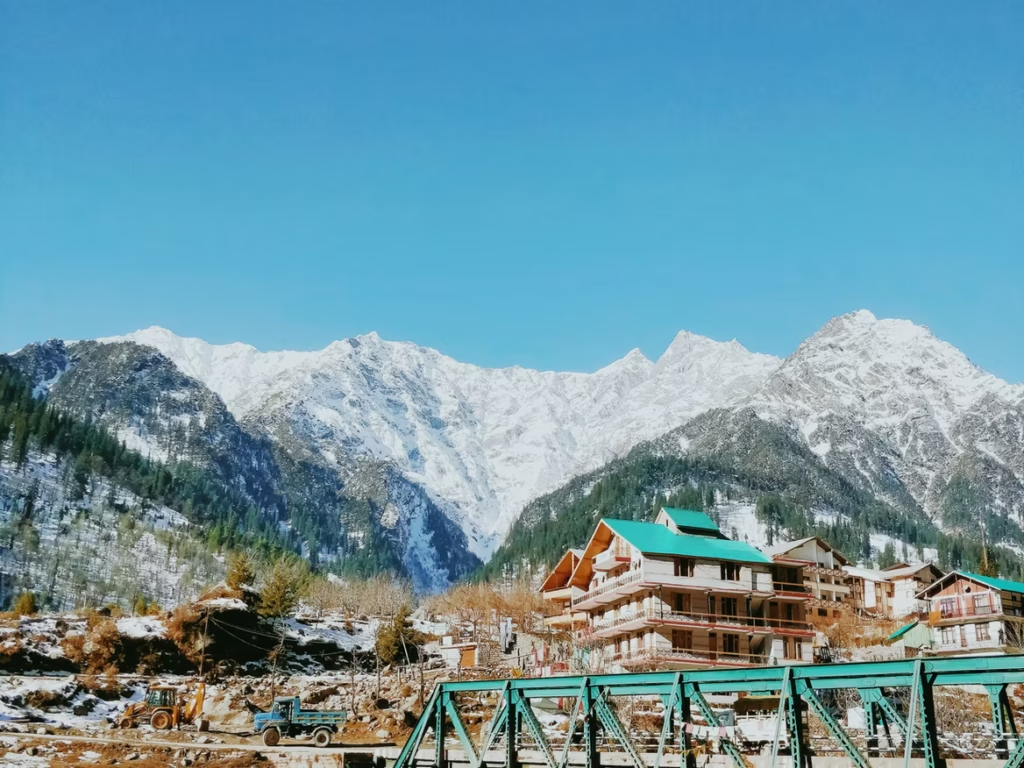
Winding paths framed by tall snow-capped peaks, scattered colorful villages and charming cafes with hot piping momos – the scenic Shimla to Manali highway is a road tripper’s paradise. This northern mountain route offers non-stop enchanting vistas of the Himalayan foothills, with ample pitstops to experience the local cultures along the way. Covering a distance of about 240 kms, the 5-6 hours drive is best enjoyed over 2-3 days for comprehensive exploration. The cool breezy hill towns of Shimla and Manali serve as idyllic basecamps, surrounded by outdoor adventures, spiritual sites, colonial architecture and abundant nature. This guide takes you through the main attractions spanning this route, promising stunning landscapes, adrenaline rush inducing activities and delicious food discoveries around every turn! Scenic beauty of Manali (Source: Unsplash) Shimla and Nearby Attractions Nestled amidst lush green hills, Shimla is the perfect starting point to kickstart your road trip adventure. Take a stroll down the bustling Mall Road, lined with restaurants, shops and historic buildings. Stop by the towering Christ Church and charming Gaiety Theatre dating back to the British Raj era. The majestic Jakhu Temple, perched atop the highest peak in Shimla, offers panoramic views of the Shivalik ranges. Be sure to also ride the narrow-gauge Kalka-Shimla Toy Train for an unforgettable journey from Kalka to Shimla through mountain tunnels and forests. Just outside Shimla lie stunning natural wonders like Kufri, India’s popular skiing destination. Hike through Alpine meadows and forests here. Naldehra’s iconic golf course surrounded by deodar trees is another must-visit. For breathtaking views, head to Chail, known for its lush expanse of greenery. Shimla also makes for a great base to enjoy adventure activities like rafting, camping and mountain biking. Take a day trip to nearby Mashobra and enjoy picnic lunches by the river. With its old-world charm and natural splendor, Shimla is the perfect opening chapter to your road trip story. The real beauty of Shimla (Source: Unsplash) Journey from Shimla to Manal The drive from Shimla to Manali is universally renowned for its sensational mountain vistas. Curve around roads hugged by tall pine trees, with the Beas gushing alongside in many stretches. It’s recommended to cover the distance over 2 days, stopping overnight in the village of Naggar. Here, visit the ancient Naggar Castle with its unique stone and wood architecture. Further along, the bustling town of Kullu makes for an exciting pitstop. Try rafting in the Beas or hiking nearby places like Kasol. The scenic hamlet of Jibhi with its waterfalls and trout fishing spots is another great place for some quietude. Stop frequently along the route to photograph the mesmerizing landscapes. Closer to Manali, experience Manikaran Sahib’s hot springs or visit Naggar’s quaint Nicholas Roerich art gallery. The mountainous journey from Shimla to Manali is packed with rewarding detours. A small park in the town of Kullu (Source: Unsplash) Top Attractions in/near Manali Manali’s captivating natural beauty and vibrant culture make it a must-visit. To experience the best of this charming mountain town, there are some attractions you simply cannot miss. This section highlights the top must-visit places that will allow you to soak in Manali’s allure-: Hadimba Temple – Famed for its unique four-tiered pagoda-style architecture and dedicated to Hadimba Devi. The intricately carved walls and doorway are a must-see. Mall Road – Lively main street lined with colorful shops, restaurants and cafes. Perfect place for shopping, people-watching and trying local cuisine. Old Manali – Charming old village with cobbled paths across the Manalsu River. Offers great views, spiritual vibe and quaint cafes. Solang Valley – Picturesque valley perfect for adventure activities like paragliding and zorbing in summer and skiing in winter. Rohtang Pass – Located at an altitude of 3,978 m, it offers stunning views of the surrounding mountainscapes and glaciers. Requires a permit. Manu Temple – Dedicated to the sage Manu, it is located in Old Manali and is an important pilgrimage site. Nehru Kund – A natural spring named after Jawaharlal Nehru located on the way to Rohtang Pass near Manali. Hadimba Temple, an architectural masterpiece (Source: Unsplash) Where to stay and eat With its mist-laden hillsides and old-world charm, Manali attracts travelers seeking scenic views or adrenaline-filled adventures. While the sights and activities energize your days, Manali’s excellent accommodation options ensure you have the perfect place to relax and recharge at night. From cozy guesthouses with views of the Beas River to resorts tucked away in apple orchards, Manali’s hotels cater to all budgets and styles. The options range from backpacker dorms costing under ₹500/night to lavish 5-star properties exceeding ₹15,000/night during peak seasons. For a curated list of the 10 best hotels in Manali chosen for their amenities, value and ambience, check out our previous blog post here. The list covers options in Old Manali, Mall Road, Manali town center and outskirts – so you can conveniently choose a base to match your itinerary. This is how Manali looks in the night (Source: Unsplash) An unforgettable experience The Shimla-Manali route promises an epic mountain adventure. Pack smart, make scenic playlists, and get ready to create magical memories. Follow this guide to the main attractions and experiences. Let the spectacular Himalayan terrain enchant you as you road trip through some of North India’s most majestic vistas and charming towns. You can also check out our free AI travel planning itinerary here to better organize you future trips. Free AI Travel Planner
How to Plan the Perfect Delhi to Manali Road Trip
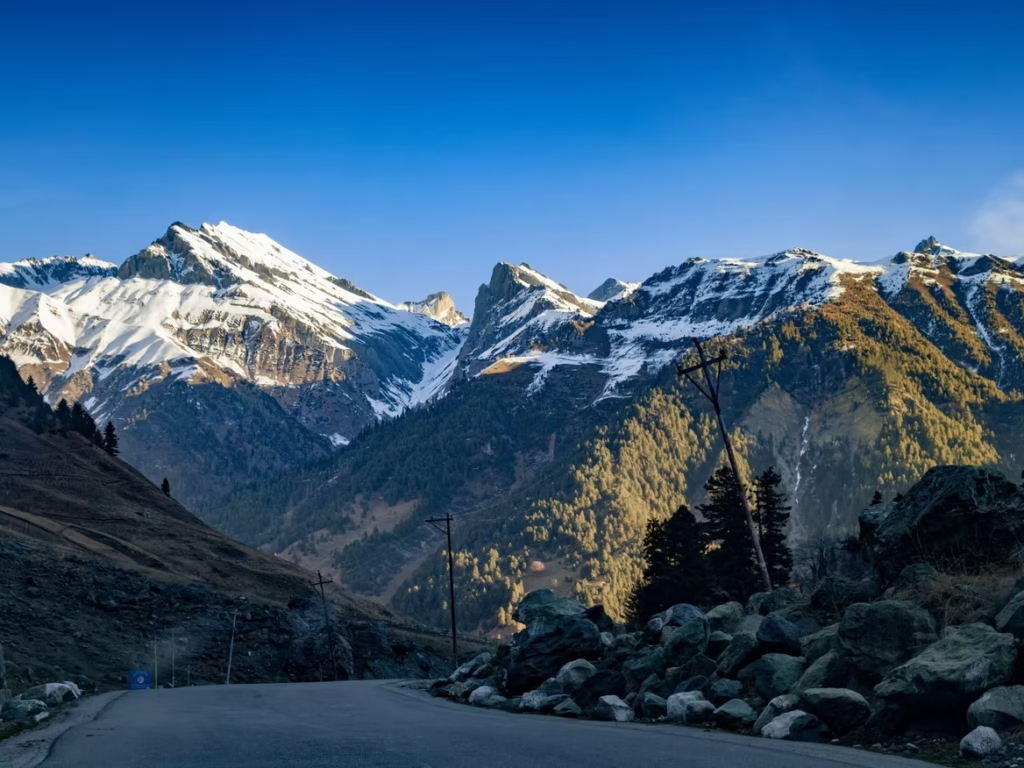
Hitting the open road from Delhi to Manali is an adventure seeker’s paradise. This popular route takes you through some of India’s most picturesque mountain scapes and charming hill towns in Himachal Pradesh. Covering a distance of approximately 470 km, the 10-12 hour drive is a must-do trip for any road trip fan. From winding roads framed by tall peaks to quaint cafes perched on hillsides, the vistas and pitstops make the Delhi-Manali highway an unforgettable experience. The route lets you immerse in Himachal’s natural beauty while discovering historic temples, adrenaline-pumping adventures, and peaceful retreats along the way. This blog post covers expert tips to help you plan the perfect Delhi to Manali road trip itinerary. Follow our recommendations on optimizing your time on the road for stunning views, good vibes and endless memories with your travel companions. A mountaineous route (Source: canva) Planning Your Route The Delhi to Manali route spans approximately 470 kilometres of incredible mountain scenery. The total driving time comes to 10-12 hours if you were to drive non-stop. However, with ideal planning, you can complete this trip leisurely over 3-5 days. Overview of the Delhi-Manali route (Source: Google Maps) The best months for the road trip are March-June before monsoon hits, or September-November after the rainy season. The rains can damage roads and cause unsafe conditions, so it’s best avoided. Summers have pleasant weather for exploring the hills. When planning your pitstops, be sure to spend time in towns like Manali, Kasauli and Shimla along the way. Recommended stopovers include Ambala, Chandigarh, Kalka and Solan as well. These towns give you a taste of Himachal’s natural beauty, history and food. Spend a day immersed in each destination en route for a well-rounded experience. Packing and Preparing Be sure to pack essentials like comfortable clothes, medicines, snacks, chargers, and spare tyres for your road trip. Don’t forget to bring warm clothing as nights in the hills can get cold. Image demonstrating packing for a road trip? (Source: canva) Also create fun road trip playlists with songs that will keep your energy high during the long drive. Make playlists for each travel companion to take turns DJing in the car! Get your vehicle thoroughly serviced 1-2 weeks before the trip – check battery, tires, brakes etc. Also stock up on extra fuel cans to have sufficient fuel supplies along the more remote stretches. Make detailed checklists for yourself and each travel companion to avoid forgetting important items. Lists should include medication, clothing suitable for various weather, electronics and chargers, and car tools. Pack snacks like dry fruits, chips and sandwiches to munch on during pitstops. Carry a small medical kit for emergencies. With some smart preparation, you’ll be set for a smooth and comfortable Delhi to Manali road trip! Top Attractions En Route The Delhi-Manali highway is dotted with amazing pitstops and attractions to cover. In Delhi, visits the ancient Sadar Bazaar for a sensory overload of colors, smells and chaat. Try the iconic chole bhature dish here. North Indian Delicacy Chole Bhature (Source: canva) Further along the route, the Gurudwara Nada Sahib in Panchkula and the temples of Kurukshetra make for important spiritual stops. When passing through Murthal, stopping for giant stuffed parathas is a must! This region is famous for its lip-smacking highway dhaba food. As you enter Himachal, spend time admiring Chandigarh’s sprawling gardens, museums and architecture. The hill stations of Shimla and Kasauli also showcase British era buildings set amidst natural beauty. Don’t miss out on the bustling Mall Road when you reach Manali. Spend evenings exploring the local cafes, bookshops and eateries. For adventure lovers, the Solang Valley offers picturesque paragliding spots and skiing during winters. You can also drive up to the Rohtang Pass for stunning valley views. Drone view of the Rohtag Pass (Source: Photo by Md Javed Akhtar on Unsplash) The route has ample hotels, resorts and quaint homestays to choose from for your stays. Remember to drive slow and safe at all times, avoiding night driving. Buckle up and keep emergency numbers handy. Twisting mountain roads unfurling magic at every turn, each pitstop telling a unique story – lose yourself in the rich fabric of Himachal on the Delhi to Manali highway. Follow our tips to customize a smooth itinerary soaked in history, food and natural allure. Depart with lasting memories and friendships as you drive into the heart of Himalayan magic. To know about the best hotels to stay in Manali, click here. For planning a destination wise trip for Manali, you can access our free AI travel planner below. Free AI Travel Planner
Top Budget Hotels in Manali for a Mountain Getaway
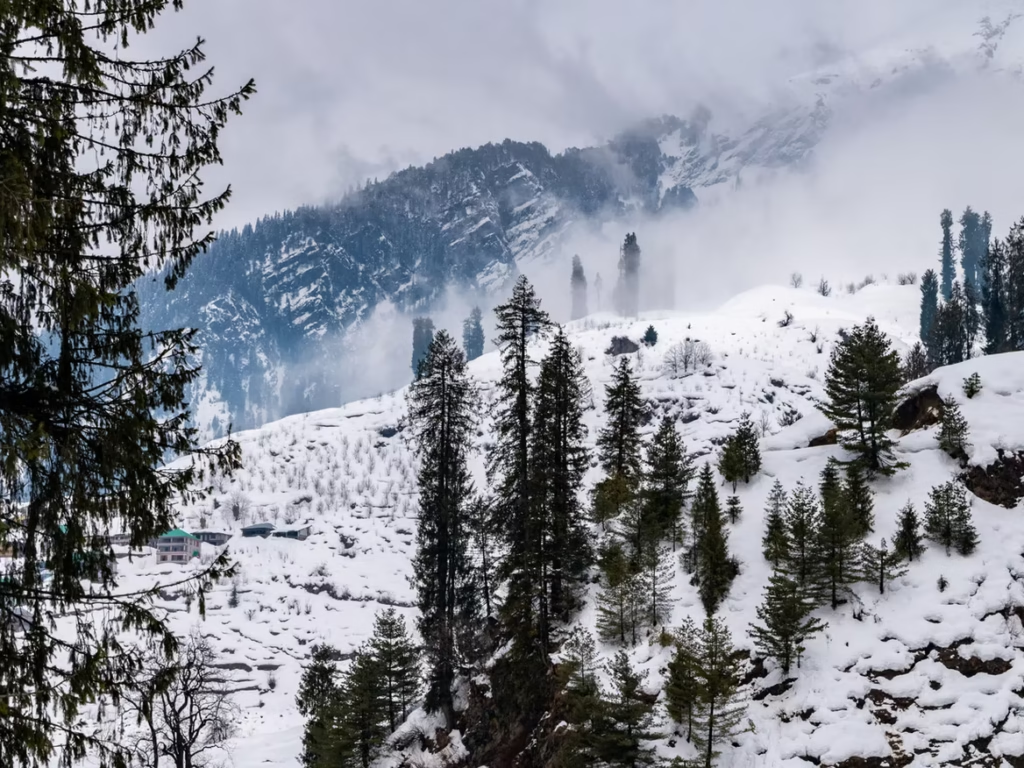
Manali is one of the most idyllic hill stations in India and a haven for budget travellers. Surrounded by snow-capped peaks, lush green forests, and the Beas River winding through the valley, Manali’s natural beauty is unparalleled. A snowy landscape with scarce vegetation (Source: canva) From adrenaline-pumping adventure activities like paragliding and rafting to serene treks to ancient temples, Manali has something for everyone. While accommodations can be expensive, there are many excellent budget hotel options to enjoy Manali without burning a hole in your wallet. In this blog post, I recommend the top 5 budget hotels in Manali for an affordable mountain vacation. Whether you’re a backpacker, solo traveller, couple, or family, you will find suitable lodging that fits your budget. I have handpicked these hotels based on location, amenities, reviews, and value-for-money. The Orchard Greens Hotel View of the Orchard Greens Hotel (Source: theorchardgreens.com) Conveniently located next to Mall Road, The Orchard Greens Hotel offers budget rooms starting Rs.1360 per night. It is walking distance from top attractions like Hadimba Temple and Manu Temple. Compact yet comfortable rooms have amenities like free Wi-Fi, room service, LCD TVs, attached bathrooms and mountain views. The warm staff and in-house restaurant serving delicious meals enhance your stay. Make use of the fitness center or get sightseeing assistance at the travel desk. Panoramic views of Manali can be enjoyed from the rooftop. The central location, essential amenities and close proximity to main town make it ideal for solo travelers, couples and small families wanting a value for money hotel in the heart of Manali. Hotel Snow Valley Resort An insider view of the Hotel Snow Valley Resort (Source: booking.com) Escape the bustle of Manali by staying at Hotel Snow Valley Resort, nestled amidst verdant gardens in tranquil Old Manali. Starting at Rs. 1500 per night, spacious rooms with modern amenities exude rustic mountain charm. Floor-to-ceiling windows showcase sweeping valley vistas while you wake up to bird songs every morning. Focused on rejuvenation, the resort offers yoga sessions, relaxing massages and day excursions. Savor delicious vegetarian fare at the restaurant after working up an appetite on nature walks. Adventure seekers try paragliding flights and river rafting nearby. Shuttle service provides easy transfers to Mall Road. Snow Valley Resort’s serene setting, indulgent amenities and warm hospitality make it a wonderful retreat for families and couples seeking quality time in nature’s lap away from Manali’s crowds, yet close enough to town. Zostel Manali View of Zostel Manali in the evening (Source: zostel.com) Zostel Manali is every backpacker’s paradise, located close to Mall Road with beds starting at just Rs. 500 per night in dorm rooms. The lively hostel brims with young travelers from around the world bonding over free Wi-Fi, books, board games and cafe chatter. Daily activities like paragliding, village walks and karaoke nights promise non-stop fun. Whip up free home-cooked meals in the common kitchen and swap travel stories at the terrace cafe. Clean and colorful dorms allow budget travelers to save money for adventure sports. Zostel’s sociable ambience, basic comforts and wallet-friendly rates make it the ultimate hangout for solo travelers and groups wishing to meet like-minded people while enjoying Manali’s attractions on a shoestring budget. If you are considering Zostel Manali as your perfect stay destination, we have some good news for you. The hotel is located in multiple destinations throughout the city. Here is a list of all of them- Zostel Manali (Old Manali) Zostel Manali (Vashisht) Zostel Manali (Burwa) Zostel Homes Pangan (Manali) Zostel Dhobi Hotel Tibetan Classic A representative image of Hotel Tibetan Classic (Source: canva) Escape the tourist crowds by staying at Hotel Tibetan Classic in laidback Vashisht village, with traditionally decorated rooms from Rs. 1500 per night. Intricate woodwork, plush fabrics and Buddhist murals transport you to Tibetan culture. Start your day with hot Butter Tea while soaking up mountain views from the garden cafe. Wind down with a traditional Thai massage or peek into astrology sessions at the in-house wellness center. The multi-cuisine restaurant serves flavorful Tibetan momos and thukpas. Hotel Tibetan Classic’s charming Ladakhi-style architecture, spiritual ambience and tranquil village location make it perfect for couples and families wanting to experience the Buddhist side of Manali. The friendly staff and cultural immersion opportunities add to its allure. Johnson Lodge Manali A view of the Johnson Lodge Manali in the morning (Source: tripadvisor) Located in the heart of Manali near Mall Road, Johnson Lodge is a value for money stay with spotless rooms starting Rs. 1000 per night. The lodge greets you with a bright yellow exterior and a beautiful garden. Airy rooms with tasteful wooded interiors provide a comfortable retreat after a long day of sightseeing. Guests appreciate the friendly staff, complimentary breakfast, Wi-Fi access and amenities like room service, safety locker and laundry. The in-house restaurant serves delicious Indian and continental fare. Johnson Lodge’s central location, budget-friendly rates and warm hospitality make it a convenient choice for couples and solo travelers who want to stay near Manali’s main hub without spending too much. Unwind in comfort knowing all attractions are a quick stroll away. For information about the best time to visit Manali, you can read this blog. If you want to learn more about which destinations to visit in Manali you can check out our AI itinerary planner below which can provide a list of the must visit destinations in Manali, as per your travel preference and budget. Free AI Travel Planner
The Ultimate Manali Travel Guide: How to reach and get around the mountain town.
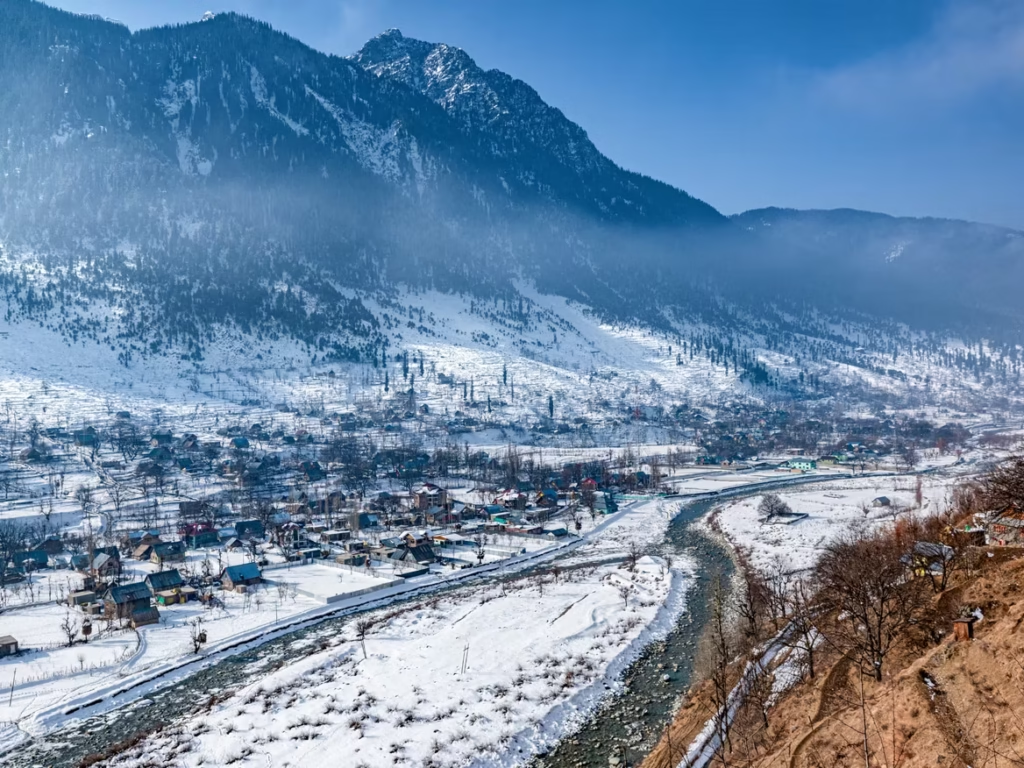
Situated high up in the Himalayas, Manali has rightfully earned its reputation as one of India’s top tourist destinations. Framed by snow-capped peaks and boasting lush green forests, this quaint mountain town promises postcard-perfect views at every turn. From adventures like rafting and skiing to cultural treasures like ancient temples, Manali attracts travelers seeking both adrenaline rush and serenity. The laidback cafes, Tibetan monasteries, and local handicraft shopping beckon as well. Regardless of whether you seek nature’s embrace or prefer soaking in history, Manali delivers ample opportunities. Its cool and pleasant climate during summer provides welcome respite from India’s sweltering heat. Reaching this mountain gem is easy, and getting around quite hassle-free. This guide will equip you to plan an immersive trip to Manali. The astounding beauty of Manali during the Winters (Source: canva) Arriving in Manali: Journey to the Mountains Manali is well connected to the other parts of India through air, road and rail. You can reach the hill station through the following methods: By Air The nearest airport is Bhuntar Airport located around 50km from Manali in the Kullu district. It has regular flights from Delhi, Chandigarh, Shimla and other major cities by airlines like Air India, IndiGo, SpiceJet, etc. Taxis charge about ₹2000 to reach Manali from the airport. One can also take a bus which costs around ₹200 per person. By Rail The closest major railway station is Joginder Nagar railway station, approximately 165km from Manali. It falls on the Pathankot–Jogindernagar narrow gauge railway line. The train route is incredibly scenic but takes around 10 hours from Pathankot. From Joginder Nagar you can hire a taxi or take a Himachal Road Transport Corporation (HRTC) bus to cover the 6 hour onward journey to Manali. By Road The most popular way to get to Manali is by road. National Highway 21 connects Manali to Chandigarh and further to other major cities. The highway is well maintained with scenic views throughout. Luxury Volvo buses by HRTC provide a comfortable overnight journey from Delhi, taking about 14 hours. You can also hire a private taxi or self-drive your own car on this route. Zigzag roads win you over with mountain vistas. Stopovers in towns like Karnal and Bilaspur can break the trip. If you want to plan a road trip from Delhi-Manali, read this blog. Train taking a sharp turn on a mountainous bridge (Source: canva) Day Trips from Manali: Nearby Gems to Explore With its location in the hills, Manali serves as an ideal base to explore scenic destinations nearby. Some recommended day trips are: Rohtang Pass Located 51 km from Manali, the high mountain pass of Rohtang lies at an altitude of 3978 m. Visit to see snow even in summers and gorgeous views. Requires permit. Solang Valley Just 13 km from Manali, Solang is renowned for adventure sports like paragliding, zorbing and skiing. During summer you can hike here or picnic by the river. Naggar Village This quaint village 20 km from Manali has European style castle, temples, museums and art galleries to explore on a day trip. Manikaran The religous town of Manikaran located 45 km from Manali attracts pilgrims to its hot springs and beautiful Sikh gurudwara. With so much natural beauty around, taking day trips from Manali allows you to make the most of your time there. Follow the tips above for memorable short excursions. Morning View of Manikaran across the shore (Source: canva) Manali awaits! With its idyllic setting amidst snow-clad mountains and spiritual aura, Manali casts a spell on all who visit. Reaching this Himachal town is easy by air, road and rail. Navigating within Manali can be done conveniently by buses, rental vehicles, bicycles or on foot. The destinations near Manali like Rohtang Pass and Solang Valley promise adventure and stunning vistas. Take scenic day trips and partake in activities like paragliding for once-in-a-lifetime experiences. From ancient temples to gushing rivers, Manali is a gateway to some of India’s most prized natural wonders. You can also check out this free AI planner travel to better plan your trips as per you desirable preferences and budget constraints. Free AI Travel Planner
Planning a Trip to Manali this Summer? Here’s What You Need to Know About the Weather
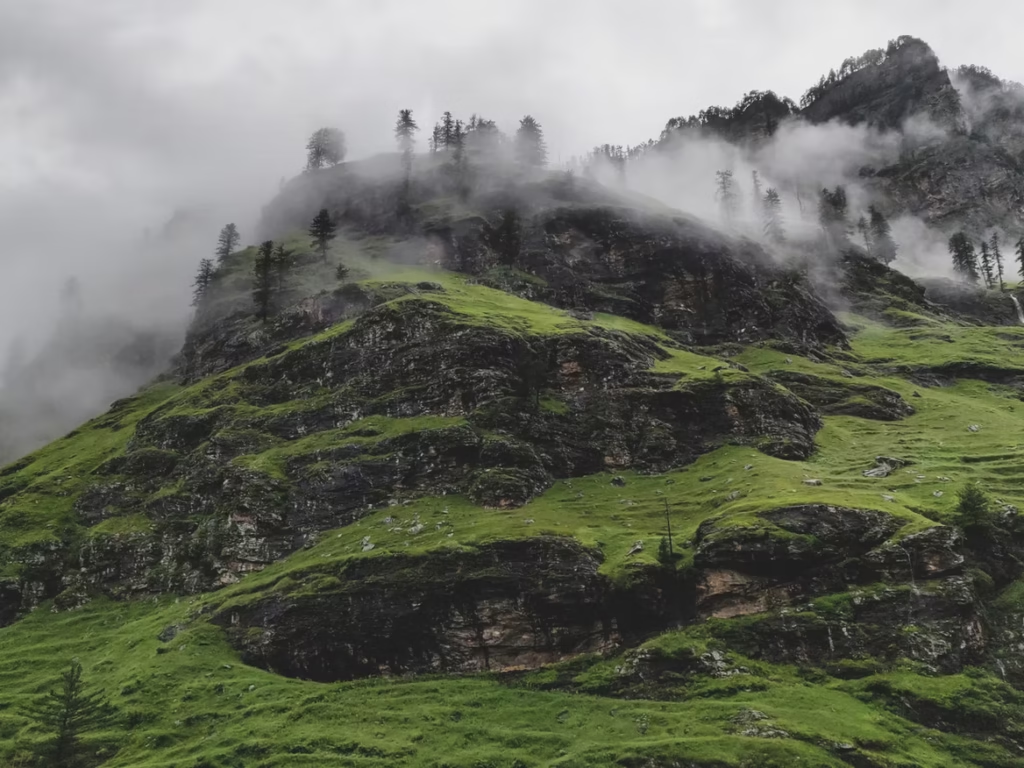
Nestled high up in the magnificent Himalayan mountains of Himachal Pradesh, Manali stands as one of India’s most idyllic and popular summer retreats. As the sweltering summer months approach, you may be dreaming of planning a rejuvenating escape to this picturesque hill station, away from the scorching heat of the plains. However, before packing your bags with gusto, it is essential to understand Manali’s fickle climate and weather patterns during the summer. The weather in Manali can fluctuate wildly and be extremely unpredictable in the summer months between May to August. Sudden downpours, chilling thunderstorms, misty clouds obscuring mountain views – the weather vagaries are manifold. View of a foggy mountain peak (Source: canva) Thus, advance planning and preparation becomes critical to truly enjoy the summer charms of Manali despite the temperamental climes. In this blog, I will provide a detailed overview of Manali’s weather and climatic conditions. You will get insights into the temperature range, humidity levels, frequency of rainfall, sunny intervals, and the impact of altitude on weather during this season. Additionally, I will share how the weather affects key summer activities like sightseeing, trekking, adventure sports, and transportation around Manali. By understanding all these facets, you can pack smartly, plan your summer holiday efficiently and make the most of your time in Manali irrespective of the weather gods’ whims! Manali’s weather: Quick glance Weather in Manali across the year (Source: cottagesinmanali) Summer (April – June) Summers see pleasant daytime temperatures in the range of 15°C to 25°C. However, humidity levels start rising to 65-70% by May end indicating the onset of monsoon. Rainfall also increases from June with occasional heavy downpours. Monsoon (July – September) The monsoon months are humid with average humidity levels spiking to 75-80%. Persistent heavy rainfall occurs with a monthly average of 350mm during peak monsoon season. Temperatures are cooler in the range of 12°C to 20°C.] Winter (December – February) Winters are dry and cold with negligible rainfall. Humidity levels drop further to 40-50%. Temperatures plummet below freezing point after sunset to -5°C with highs of about 10°C during the day. Spring (March – April) The spring months of March and April see temperatures rising to pleasant highs of 18°C to 25°C though nights can still be cool in Manali, with moderate rainfall occurring as light showers during this pre-monsoon transition period. However, sudden weather changes including snowfall at higher altitudes are common as the region moves from winter chill to summer warmth. Best time to visit Manali A camping site full of tourists (Source: canva) Now arrives the most awaited question- What is the best time to visit Manali? However, the answer is that it completely depends on your personal preferences. Here is a list of the pros and cons of visiting Manali in each of the seasons-: Summer (April – June) Pros: Warm, sunny days perfect for sightseeing and photography Can participate in adventure activities like paragliding, camping Scenic mountain views before monsoon fog sets in Fewer tourists and cheaper prices before mid-May Cons: Unexpected heavy showers start by late June with monsoon Rohtang Pass closed due to snow clearance Monsoon (July – September) Pros: Lush green valleys and fores with beautiful views Discounted rates ideal for budget travellers Great for white water rafting with raging rivers Less crowded compared to peak summer Cons: Heavy persistent rainfall leads to landslides Frequent disruption of travel due to landslides and road blockages High chances of road closures especially to Rohtang Pass Limited views due to fog and cloud cover Winter (December – February) Pros: Snow-covered landscapes look picture perfect Activities like skiing, snowboarding, snowmobiling Discounted hotel rates and fewer tourists Hot springs and spas ideal in cold weather Cons: Extremely cold temperatures ranging from -5°C to 10°C Heavy snowfall can block roads and led to being stranded Limited connectivity and accessibility due to road closures Most activities closed down during peak winter Spring (March – April) Pros: Pleasant weather with temperatures rising up to 25°C Lush valleys and flowering fruit orchards Off-season discounts on stays continue Religious festivals like Holi and Easter Cons: Sudden snowfall on higher altitudes still possible Some tourist spots remain closed before peak summer High chances of rain during March Visiting Manali in each season arrives with their own set of pros and cons. Even though some of the pros may overweigh others, visiting the hill station in every season comes out as a completely different experience. What to pack for your Manali trip? A snowy landscape in Manali (Source: Unsplash) Here are some packing recommendations for Manali for each of the four seasons round the year-: Summer (April-June) Summers in Manali have pleasant daytime temperatures, but the high altitude can lead to sun exposure. Cotton clothes that are light and airy suit the generally hot climate. Hats, sunglasses and sunscreen become essential to protect against UV rays at high altitudes. The evenings can get breezy and cooler, so carrying light jackets is advised. For outdoor activities like hiking, sturdy trekking shoes with a good grip are a must. By mid-June, monsoon showers begin, so packing umbrellas becomes vital for protection. Monsoon (July-September) The monsoon months witness heavy downpours in Manali. Rain jackets and umbrellas are a must to stay dry during the persistent showers. With trails becoming slippery, sturdy waterproof boots help maintain stability and prevent falls. Quick dry clothes that can wick moisture are recommended to handle humidity and sudden downpours during outdoor excursions. Leech socks offer protection from leeches prevalent during hikes in the rainy season. Carrying medicines for common ailments like allergies, cold and body aches provides comfort in the damp weather. Winter (December-February) The cold dry winters of Manali call for ample warm clothing. Heavy woolens including sweaters, thermals and jackets help insulate the body from the chilling cold. Snow boots with good traction and gaiters are
Albania’s Albanian Riviera: Sun, Sea, and Untouched Beauty
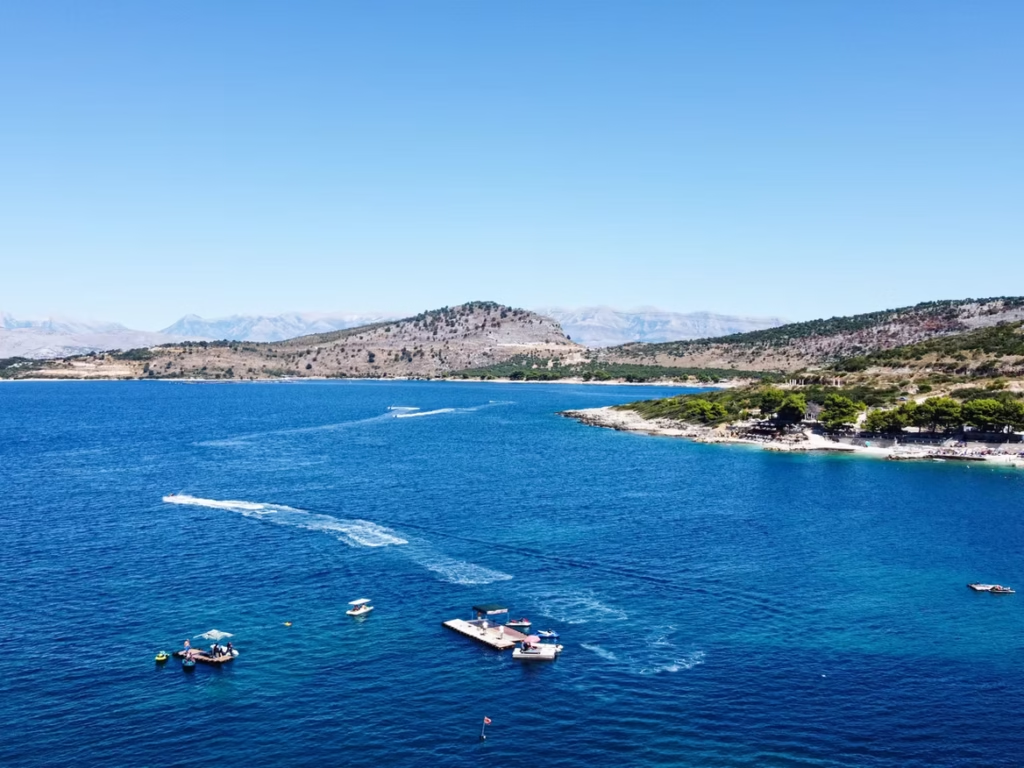
Tucked away along the Adriatic Sea, you’ll find a hidden holiday gem – the Albanian Riviera. Situated away from the tourist hordes, this sun-soaked coastline entices with aquamarine waters, pristine beaches stretching as far as the eye can see, and lovely limestone cliffs plunging into the sea. Sip espresso at beachside cafes under 150-year-old olive trees, swim among the caves and coves, and hike trails that wind past sleepy villages seemingly untouched by time. That’s just a part of what this little-known slice of Mediterranean paradise offers you. Serene beauty of a Mediterranean Beach (Photo by Bleron on Unsplash) Here is how to experience the pristine glory of Albanian Riviera- 1. Gjipe Beach Aerial view of a crowded beach alongside blue waters (Photo by Renaldo on Unsplash) The word “Gjipe” is derived from the Albanian word for “peace”. As its name suggests, arrive early in the morning to experience Gjipe’s tranquility all to yourself. Nestled at the end of a steep cliffside trail, Gjipe Beach is a hidden gem along the Albanian Riviera. With vistas that look airbrushed and serenity unmatched by larger beaches, Gjipe offers an unspoiled Mediterranean escape. Its remoteness provides a calming reprieve from modern life’s busyness. 2. Ancient Dhermi Huge mountains of Dhermi stretched across (Photo by Sara on Unsplash) In Dhermi, you can uncover ancient ruins and natural beauty in just one charming destination. The most taken route is to hike to the 6th century Monastery of St. Theodore and 4th century BC fortresses for insights into medieval history amidst mountain-top views. Afterwards, descend to Dhermi’s pristine beach, renowned as one of Albania’s most beautiful, for a scenic Mediterranean escape. 3. Drymades Stone ruins of an ancient Greek amphitheater (Photo by Daria on Unsplash) When the sun goes down, Drymades Beach comes alive with lively beach parties, bonfires, and all-night dance clubs. Sip local raki cocktails, sway to modern and folk music under the stars, and meet fellow travelers late into the evening. This sandy shoreline transforms into the Riviera’s most vibrant nightlife destination. 4. Ksamil Islands Top-down view of Ksamil Islands with surrounding emerald green ocean (Photo by Altin on Unsplash) Off the coast of Sarandë lies the untouched beauty of Ksamil Islands, a small archipelago with three main islands – St. Nicholas, Basta, and Ksamil – connected by picturesque footbridges. The Ksamil Islands offer a perfect blend of nature, relaxation, delicious dining, and vibrant nightlife, while retaining a peaceful, remote island feel. This island paradise often remains unexplored and unknown by the tourists making it one of the most underrated destinations on the Riviera. So don’t you rather miss it out! 5. Llogara Pass Aerial view of roads stretching across miles of a green terrain (Photo by Elion on Unsplash) Llogara Pass, reaching 1,043 meters above the Albanian Riviera, offers spectacular views of the coastline and Ionian Sea. As you drive the scenic mountain road, you can stop at lookouts to see beaches unfolding below. One fun activity is to hike the fragrant pine forests and watch for golden eagles overhead. The Llogara mountain pass makes for a rejuvenating pitstop on this Albanian roadtrip. At last, there is also the Llogara National Park nearby which is rich in biodiversity having over 1,000 plant species and roaming wild horses.
Belgium’s Artistic Marvels: Exploring the Flemish Masters and Beyond
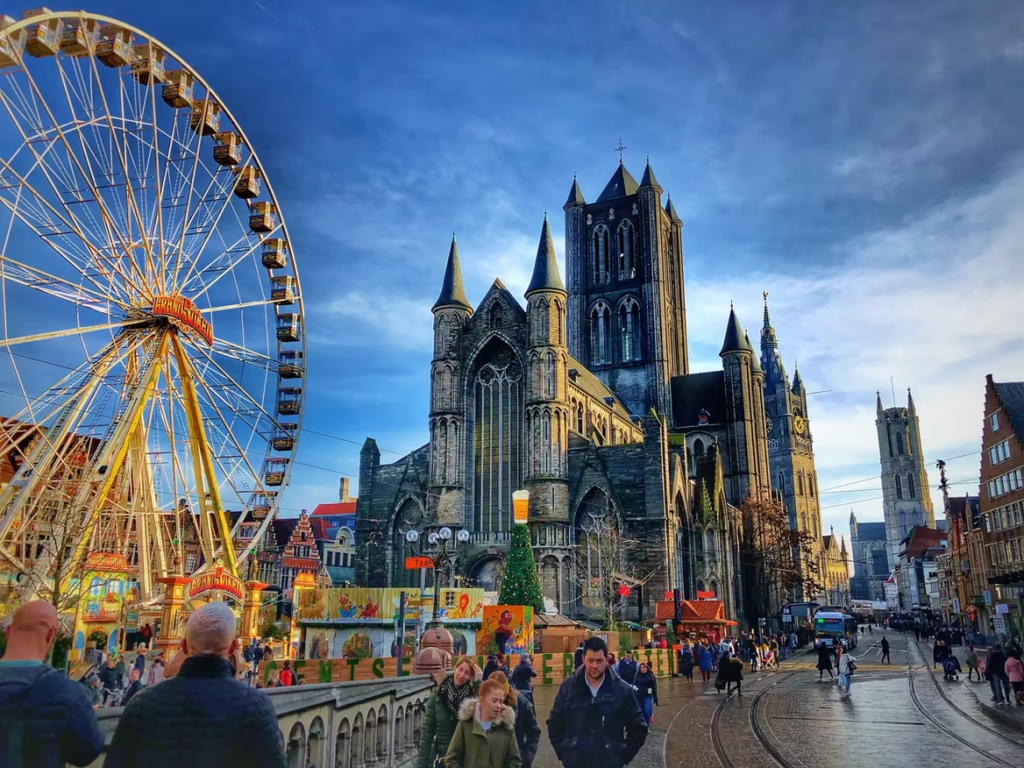
In the very heart of Western Europe rest a small but mighty land – Belgium. Though often overlooked on the crowded European map, this plucky country holds an embarrassment of artistic riches within its compact borders. Belgium is a country where the medieval melds seamlessly with the modern. Centuries-old cathedrals and guild houses brush up against contemporary art museums and sleek cafés. This fusion creates an energetic artistic spirit that permeates every city and town. An eclectic aesthetic where old and new are not only embraced, but celebrated. From the vibrant whirl of brushstrokes by Baroque masters to the soaring spires of Gothic grandeur, Belgium offers a bonanza of visual splendor awaiting discovery. Once you arrive here, one thing becomes clear – you don’t have to be big to make a mammoth artistic impact. Sometimes, the greatest creative wonders come in small packages. And this is what this small euro- nation proves this magnificently. A beautiful view of a Belgian city (Source: Unsplash) Now, sit back and relax while we take you across the top attractions in the country- Brussels A street full of people in Brussels (Source: Unsplash) Brussels remains one of Europe’s most enticing capitals for art and architecture devotees. The city brings Belgium’s finest structural designs together, from medieval guildhalls to Art Nouveau façades. The Grand Place exemplifies Brussels’ aesthetic appeal with Gothic towers and intricate baroque details adorning its historic central square. In Brussels you can stroll through ornate Art Nouveau neighborhoods to admire Victor Horta’s UNESCO-protected houses, including the magnificent Stoclet Palace. For an immersive overview, the CIVA Centre’s exhibits masterfully display eight centuries of Brussels’ architectural evolution. As a pilgrimage point for Art Nouveau, the city’s mansions, churches, and commercial buildings transform Brussels into a living museum of Belgian craftsmanship and style. Places to visit- Grand Place, Art Nouveau Neighborhoods, Victor Horta Houses, CIVA Centre Bruges Steep Sloped houses across a river in Bruges (Source: Unsplash) Romantic canals and medieval charm establish Bruges as one of Europe’s most picturesque art cities. Bruges brings the legacy of Belgian art to life with architecture spanning eight centuries. You can visit the egg-shaped Lake of Love for stunning views of the 13th century belfry towering over august buildings or the Groeningemuseum where 15th century Flemish Primitives take center stage, including Jan van Eyck’s “Madonna with Canon van der Paele.” Wander around beetling cobblestone lanes and discover almshouses, patrician residences, and hidden churches adorned with works by Bruges’ Flemish masters. For a quintessential Bruges experience, take a moonlit canal boat ride and enjoy the city’s twinkling architectural marvels, shaped by generations of artists’ brushstrokes. Places to visit- Lake of Love, Belfry Tower, Groeningemuseum Ghent A cathedral in Ghent (Source: Unsplash) With its medieval towers, guildhalls, and patrician mansions reflected in winding canals, Ghent encapsulates the splendor of historic Flemish cities. As one of the largest canal metropolises, Ghent intertwines art and architecture seamlessly. St. Bravo’s Cathedral safeguards the Ghent Altarpiece, featuring the Adoration of the Mystic Lamb, Jan van Eyck’s pioneering 15th century masterwork. Bask in the grandeur of Graslei’s guild houses along the Leie River or venture to the 1460 Belfry and its bell tower views rising above a labyrinth of architectural marvels below, Ghent is for you. From Romanesque to Renaissance to Gothic revival styles, the city exemplifies Belgium’s finest architectural achievements and the art it has inspired for centuries. Place to visit- St. Bravo’s Cathedral, Graslei, Belfry of Ghent, Gravensteen Castle Antwerp Aerial View of a huge building across a river (Source: Unsplash) As the center of baroque style, Antwerp indulges art lovers with Rubens’ lavish paintings around every corner. The ornate guildhouses and step-gabled warehouses lining the Scheldt River reflect the prospering port’s 16th century Golden Age. Make a pilgrimage to the Rubenshuis, the iconic painter’s home and studio, to view his epic works firsthand and lose yourself within Antwerp Cathedral, whose towering Gothic spire dominates the skyline, while interiors house art-adorned chapels and the impressive Raising of the Cross triptych. As the day winds down, join locals at a lively cafe along Grote Markt square, Antwerp’s radiant centerpiece, and toast to the city’s artistic heritage lasting through the centuries. Places to visit– Rubenshuis, Antwerp Cathedral, Grote Markt, Plantin-Moretus Museum Leuven Roadside view of a street in Leuven (Source: Unsplash) With its soaring late Gothic St. Peter’s Church rising above ornate Renaissance facades, Leuven reflects the rich artistic heritage of central Belgium. As the capital of the Brabant province, Leuven cultivated influential early Flemish painters like Rogier van der Weyden. Wander the historic center and encounter stately 15th century architecture, including elaborately carved medieval halls lining the Town Hall. When in Leuven make sure to visit the M Museum Leuven, home to the world’s most comprehensive collection of early Netherlandish masterpieces, including rare works by Robert Campin and Jan van Eyck. After admiring the city’s architectural gems, relax at a lively outdoor café on the Oude Markt, a square bustling with university culture and legacy. Leuven provides the perfect blend of medieval charm, Renaissance beauty, and lively modern energy. Places to visit– St. Peter’s Church, Leuven Town Hall, Groot Begijnhof, Park Abbey Mechelen Windy night on the streets of Mechelen (Source: Unsplash) Mechelen is a hidden gem overflowing with architectural splendor. While smaller than Bruges or Ghent, Belgium’s capital of culture punches above its weight class with artistic treasures. Gothic spires peek above candy-colored houses along tree-lined canals. The monumental City Hall lords over the central square, beckoning visitors inside to see its lavish interior and paintings. St. Rumbold’s soaring cathedral towers above all, its 556-foot spire climbing to the heavens. As day fades to night, witness Mechelen’s buildings glow under spotlights while strolling canal-side and listening to carillons ring out from church towers.

